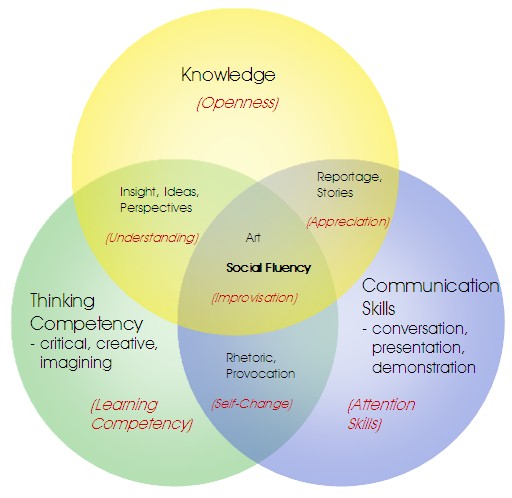 (chart is explained in more detail in this earlier Gift/Generosity Economy article) If you read the business press, you will find, just about every day, stories about acquisitions and takeovers of small companies by bigger companies. Some large corporations now brag that their business is taking over small companies. The studies by experts in corporate finance have repeatedly shown that in 70-90% of cases these transactions “destroy value” — in other words, the value of the combined entity is less than the value of the two combining entities before the combination. Yet the share value of the combined entity is usually greater than that of the two combining entities. What’s going on here? The corporations would have you believe that the combination promises “economies of scale” — that redundant positions can be eliminated, duplicate processes eliminated, volume discounts obtained from suppliers, and efficiencies obtained by combining operations. Anyone who has ever been through a combination can tell you that this almost never occurs. In fact, costs rise after the combination because of diseconomies of scale — the larger the organization, the greater the hierarchy, the more the bureaucracy, and the more infrastructure is needed to keep it all connected. Small is agile. Large is clumsy. There are no efficiencies of scale. So why do these transactions still occur? In a word, power. Consolidation isn’t about the consolidation of resources, it’s about the consolidation of power. Size gives you four types of power:
This is a self-perpetuating vicious cycle. We aren’t going to solve it through political means, or by trying to find ethical companies to buy from (there are few left, and those that are left cannot compete with slave labour wages of the oligopolies, so most consumers can’t afford, on their slave labour wages, to buy ethical, quality, or healthy products). The only solution lies in walking away from the oligopoly economy and creating our own Peer Production / Generosity Economy. This alternative economy is based on maximizing well-being, not corporate profit. It is based on trust, not power. It is based on sharing and equalization, not on greed. To participate in this alternative economy, we each have to invest something instead of money: our time. The Generosity Economy is based on knowledge — knowledge of who can and will do what, and who needs what. It is based on the liberating principle that instead of working ‘for a living’ doing something we hate so we can afford to buy what we need, we instead produce what we’re good at producing (and like producing), put it on the table for others to take, and take back (from what others have produced) what we need. It’s that simple. It’s entirely economically viable, but it will require a major investment of time to set up and maintain the self-managed knowledge bases of what we have to offer, what we need, and who is available and interested in co-producing with us other stuff that’s needed. We are already Peer Producing a lot of things: Open Source software, information and entertainment on the Internet (Creative Commons), scientific exchange, and social collaborations (e.g. community barn-raisings and community broadcasters, and volunteer work, which gives the ‘donor’ as much as the ‘recipient’). Many non-Western cultures give without expectation of payment, because they know that an investment in social relationships always ultimately pays big dividends. The Net Neutrality champions are working hard to prevent the oligopolies from increasing the price paid for Internet bandwidth to producers, including Peer Producers. The oligopolies want to price uploading out of the reach of the rest of us, to preserve their oligopoly on production. They want us only to consume, to download, and of course they want us to be able to consume only what they produce, at their fixed price. The whole idea of Peer Production is to let us all become producers, let us all collaborate with others, ad hoc, where multiple skills, talents and resources are needed to produce something that’s needed, and, because this production is shared, generously, to let us obtain what we need from others. In the case of needs that are material (physical goods and services that must be provided hands on), these Peer Production networks should generally be local, community-based. Sending goods and people long distances when more local sources are available is wasteful and dysfunctional (and remember, there are no economies of scale). In the case of needs that are not material (those that can be provided for virtually, or as bits instead of atoms) the Peer Production networks can be global, provided anytime from anywhere. Individually, and separately, we can’t compete with the power of oligopolies. But together, working collaboratively as peers, we can have far more power over our own lives, our economy, our society, and the well-being of all-life-on-Earth, than oligopolies could ever dream of having. A century ago, to fight the corporatist oligopolies, we organized in labour unions. Peer Production and the Generosity Economy is the 21stcentury ‘labour union’, united this time not to negotiate with producers, but to render them obsolete, to replace them. Category: Alternative Gift Economies
|
Navigation
Collapsniks
Albert Bates (US)
Andrew Nikiforuk (CA)
Brutus (US)
Carolyn Baker (US)*
Catherine Ingram (US)
Chris Hedges (US)
Dahr Jamail (US)
Dean Spillane-Walker (US)*
Derrick Jensen (US)
Dougald & Paul (IE/SE)*
Erik Michaels (US)
Gail Tverberg (US)
Guy McPherson (US)
Honest Sorcerer
Janaia & Robin (US)*
Jem Bendell (UK)
Mari Werner
Michael Dowd (US)*
Nate Hagens (US)
Paul Heft (US)*
Post Carbon Inst. (US)
Resilience (US)
Richard Heinberg (US)
Robert Jensen (US)
Roy Scranton (US)
Sam Mitchell (US)
Tim Morgan (UK)
Tim Watkins (UK)
Umair Haque (UK)
William Rees (CA)
XrayMike (AU)
Radical Non-Duality
Tony Parsons
Jim Newman
Tim Cliss
Andreas Müller
Kenneth Madden
Emerson Lim
Nancy Neithercut
Rosemarijn Roes
Frank McCaughey
Clare Cherikoff
Ere Parek, Izzy Cloke, Zabi AmaniEssential Reading
Archive by Category
My Bio, Contact Info, Signature Posts
About the Author (2023)
My Circles
E-mail me
--- My Best 200 Posts, 2003-22 by category, from newest to oldest ---
Collapse Watch:
Hope — On the Balance of Probabilities
The Caste War for the Dregs
Recuperation, Accommodation, Resilience
How Do We Teach the Critical Skills
Collapse Not Apocalypse
Effective Activism
'Making Sense of the World' Reading List
Notes From the Rising Dark
What is Exponential Decay
Collapse: Slowly Then Suddenly
Slouching Towards Bethlehem
Making Sense of Who We Are
What Would Net-Zero Emissions Look Like?
Post Collapse with Michael Dowd (video)
Why Economic Collapse Will Precede Climate Collapse
Being Adaptable: A Reminder List
A Culture of Fear
What Will It Take?
A Future Without Us
Dean Walker Interview (video)
The Mushroom at the End of the World
What Would It Take To Live Sustainably?
The New Political Map (Poster)
Beyond Belief
Complexity and Collapse
Requiem for a Species
Civilization Disease
What a Desolated Earth Looks Like
If We Had a Better Story...
Giving Up on Environmentalism
The Hard Part is Finding People Who Care
Going Vegan
The Dark & Gathering Sameness of the World
The End of Philosophy
A Short History of Progress
The Boiling Frog
Our Culture / Ourselves:
A CoVid-19 Recap
What It Means to be Human
A Culture Built on Wrong Models
Understanding Conservatives
Our Unique Capacity for Hatred
Not Meant to Govern Each Other
The Humanist Trap
Credulous
Amazing What People Get Used To
My Reluctant Misanthropy
The Dawn of Everything
Species Shame
Why Misinformation Doesn't Work
The Lab-Leak Hypothesis
The Right to Die
CoVid-19: Go for Zero
Pollard's Laws
On Caste
The Process of Self-Organization
The Tragic Spread of Misinformation
A Better Way to Work
The Needs of the Moment
Ask Yourself This
What to Believe Now?
Rogue Primate
Conversation & Silence
The Language of Our Eyes
True Story
May I Ask a Question?
Cultural Acedia: When We Can No Longer Care
Useless Advice
Several Short Sentences About Learning
Why I Don't Want to Hear Your Story
A Harvest of Myths
The Qualities of a Great Story
The Trouble With Stories
A Model of Identity & Community
Not Ready to Do What's Needed
A Culture of Dependence
So What's Next
Ten Things to Do When You're Feeling Hopeless
No Use to the World Broken
Living in Another World
Does Language Restrict What We Can Think?
The Value of Conversation Manifesto Nobody Knows Anything
If I Only Had 37 Days
The Only Life We Know
A Long Way Down
No Noble Savages
Figments of Reality
Too Far Ahead
Learning From Nature
The Rogue Animal
How the World Really Works:
Making Sense of Scents
An Age of Wonder
The Truth About Ukraine
Navigating Complexity
The Supply Chain Problem
The Promise of Dialogue
Too Dumb to Take Care of Ourselves
Extinction Capitalism
Homeless
Republicans Slide Into Fascism
All the Things I Was Wrong About
Several Short Sentences About Sharks
How Change Happens
What's the Best Possible Outcome?
The Perpetual Growth Machine
We Make Zero
How Long We've Been Around (graphic)
If You Wanted to Sabotage the Elections
Collective Intelligence & Complexity
Ten Things I Wish I'd Learned Earlier
The Problem With Systems
Against Hope (Video)
The Admission of Necessary Ignorance
Several Short Sentences About Jellyfish
Loren Eiseley, in Verse
A Synopsis of 'Finding the Sweet Spot'
Learning from Indigenous Cultures
The Gift Economy
The Job of the Media
The Wal-Mart Dilemma
The Illusion of the Separate Self, and Free Will:
No Free Will, No Freedom
The Other Side of 'No Me'
This Body Takes Me For a Walk
The Only One Who Really Knew Me
No Free Will — Fightin' Words
The Paradox of the Self
A Radical Non-Duality FAQ
What We Think We Know
Bark Bark Bark Bark Bark Bark Bark
Healing From Ourselves
The Entanglement Hypothesis
Nothing Needs to Happen
Nothing to Say About This
What I Wanted to Believe
A Continuous Reassemblage of Meaning
No Choice But to Misbehave
What's Apparently Happening
A Different Kind of Animal
Happy Now?
This Creature
Did Early Humans Have Selves?
Nothing On Offer Here
Even Simpler and More Hopeless Than That
Glimpses
How Our Bodies Sense the World
Fragments
What Happens in Vagus
We Have No Choice
Never Comfortable in the Skin of Self
Letting Go of the Story of Me
All There Is, Is This
A Theory of No Mind
Creative Works:
Mindful Wanderings (Reflections) (Archive)
A Prayer to No One
Frogs' Hollow (Short Story)
We Do What We Do (Poem)
Negative Assertions (Poem)
Reminder (Short Story)
A Canadian Sorry (Satire)
Under No Illusions (Short Story)
The Ever-Stranger (Poem)
The Fortune Teller (Short Story)
Non-Duality Dude (Play)
Your Self: An Owner's Manual (Satire)
All the Things I Thought I Knew (Short Story)
On the Shoulders of Giants (Short Story)
Improv (Poem)
Calling the Cage Freedom (Short Story)
Rune (Poem)
Only This (Poem)
The Other Extinction (Short Story)
Invisible (Poem)
Disruption (Short Story)
A Thought-Less Experiment (Poem)
Speaking Grosbeak (Short Story)
The Only Way There (Short Story)
The Wild Man (Short Story)
Flywheel (Short Story)
The Opposite of Presence (Satire)
How to Make Love Last (Poem)
The Horses' Bodies (Poem)
Enough (Lament)
Distracted (Short Story)
Worse, Still (Poem)
Conjurer (Satire)
A Conversation (Short Story)
Farewell to Albion (Poem)
My Other Sites

 I‘ve written several articles about achieving Radical Simplicity, reducing our footprint to zero, to the point where we recycle everything we consume, live in harmony and balance with all-life-on-Earth, and leave no trace after we are gone.
I‘ve written several articles about achieving Radical Simplicity, reducing our footprint to zero, to the point where we recycle everything we consume, live in harmony and balance with all-life-on-Earth, and leave no trace after we are gone.












